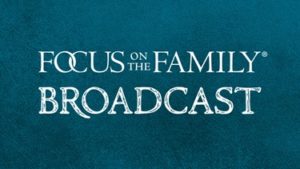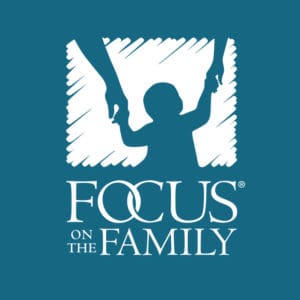
The War of Words
In this Adventures in Odyssey drama, a carelessly uttered word from Eugene creates havoc as it becomes the fashionable insult, resulting in a lesson about the power of words.
Home » Episodes » Focus on the Family Broadcast » Coming Together as a Community at Christmas
Listen in as we present a dramatic reading of a charming, inspirational story titled "When Christmas Came to Thorn Creek Bridge," a fictional historical account about a small village of people who experience conflict, and then discover the joy of forgiveness and reconciliation. We also present some light-hearted Christmas stories from Focus listeners and staff.
John Fuller: Welcome to our Christmas edition of “Focus on the Family.”
Clip:
Woman: When our youngest was about 6, she gave her daddy some socks that played Christmas tunes. She gave them to him so that he could wear them to the Christmas Eve service. The message was quite a stern message about keeping Christ in Christmas and Santa Claus out. When Steve crossed his legs, you could hear “Here comes Santa Claus, here comes Santa right down Santa Claus lane.” He was so embarrassed. He tried to stop it, but pushed the repeat button. I don’t know if I regret that gift or not because it has surely given us joy in the retelling over the years.
End of Clip
Jim Daly: Well, Merry Christmas to you, John.
John: Thank you very much, Jim.
Jim: And let me say Merry Christmas to all of our friends who are listening. I’m Jim Daly and of course, that was John Fuller and of course, John and I aren’t actually in the office right now. Focus on the Family is closed for the Christmas weekend and we recorded this in advance so we could spend a little more time with our families. We encourage you to do the same. Use the next several days to enjoy your family and your friends and celebrate the birth of Jesus Christ.
John: Well, it is a special time and of course, Jim, as you said, the staff here gets to have some extended time off. We’ll be back in the offices on Tuesday and in the meantime, if you need resources, our website is operational. It doesn’t take a day off, 24/7. That’s www.focusonthefamily.com/radio.
One of the special treats we’d like to share with you is an original radio drama that was written and produced by Kerry Kistler. He’s a chalk artist who, along with his wife, Jill, performs a kind of evangelistic variety show in churches and other venues. Now Kerry graciously gave us permission to air this drama and his presentation features the voice talent of actor and storyteller, George Sarris.
Prerecorded Story:
Narrator: “When Christmas Came to Thorn Creek Bridge” by Kerry Kistler. It has taken me some time to reconstruct this story. Fragments have come together slowly from diverse sources—crumbling newspapers, church records, a shoebox full of yellowing letters, and a few odd diaries. I have followed every thread to its end and done my best to reweave this tapestry, a story unraveled by time itself. It began with a photograph— a brittle, sepia-toned photograph discovered while doing some research in the basement archives of the Thorn Creek courthouse. The photo was remarkable enough, but it was the simple inscription written on the back which teased my curiosity. In elegant cursive lettering, was written this cryptic note: “When Christmas Came to Thorn Creek Bridge.” This is the story behind that photograph.
(Sound of wind blowing, animals barking and construction noises)
Narrator:
Construction on the Thorn Creek Bridge began during a gray and dismal week in late autumn. The weather was befitting since the bridge had been planned under a dark cloud of disagreement and suspicion. The prevailing mood around Thorn Creek was as gloomy as the sky itself and nobody quite knew how to fix it. What started as a simple splinter of opinion quickly festered into an ugly wound of division. The villagers of Thorn Creek really had no choice about replacing the existing, crumbling bridge which spanned the creek and connected the village. Everyone was in unanimous agreement that a new covered bridge was needed. Sadly, this was the only point on which everyone could agree.
This division crept in when the sturdy people from both sides of the creek exchanged ideas about how many lanes the new covered bridge should have. Some were for keeping a single-lane bridge for the sake of economy. The rest were for a wider, double-lane bridge for the sake of convenience. One half declared that two lanes were an expensive extravagance which was quite unnecessary, given the size of the village. They insisted that a single-lane bridge had adequately served their small, tucked-away village quite nicely. The other half thanked them for pointing out that a single-lane bridge had obviously hindered the growth of their community. This shifted the discussion to the question of “what was so wrong with the size of the community?” The debate raged on until one of the local preachers wearily proclaimed from his pulpit on a Sunday morning that even Paul’s “thorn in the flesh” paled in comparison to the thorny problem of Thorn Creek Bridge. Strange that a structure meant to connect people should serve to drive a solid wedge of separation between them instead.
Finally, a truce was forcibly called by the rapidly changing autumn weather which resulted in a reluctant and unhappy compromise: A two-lane covered bridge would be built, but it would be considerably simplified from the originally proposed design. Neither side was very happy over the decision and few made any effort to hide their feelings. Someone even took the liberty of changing the bridge plans by adding a long, rail-fence divider right down the middle of the bridge. It was supposedly aimed at separating the two lanes for safety sake, but everybody knew that the divider was really meant to say much more.
Thus began many years of bitter resentment which set itself into the bones of the people who continued to pass each other inside the bridge without so much as a smile, wave or nod. For years, the sad beginning of Thorn Creek Bridge stayed fresh in the minds of the local population. Eventually, it was rarely spoken of anymore. Even children who had been too young to remember the incident grew up with only a vague awareness that the abundance of local hard feelings was somehow mysteriously connected to “that bridge.” While travelers often stopped near the bridge to admire and comment on its beautiful simplicity, the local villagers had long since run out of things to say about it. After all, everything that could be said had been said and many times over.
And then, whether by accident or Providence, something happened inside that covered bridge which changed nearly every person in that small village forever.
It began on a cloudy day in mid-December when Hezekiah Hoover, a local farmer, had just purchased a wagonload of used farm items and was hauling them across Thorn Creek Bridge. Between the noise of the creek and the rumble of his stout wagon, Hezekiah never heard the muffled thud behind his rig. Unknown to Hezekiah, a wooden hay-box had tumbled off his load and landed right in the middle of Thorn Creek Bridge. A short time later, while unloading his cargo into a shed, he realized that the hay-box was missing and headed back down the road, hoping to find it along the way. And this he did.
As Hezekiah approached Thorn Creek, he saw the silhouette of his box sitting on its four stubby legs in the middle of the covered bridge. At that moment there was a sudden breaking in the clouds which caused brilliant light to wash across the bridge. It spilled through a window and poured over the hay-box, bathing it in a warm pool of light. He squinted and saw something else. The box had been empty when he loaded it only an hour before. Now, it brimmed with clean, dry hay, and a pure white cloth was draped across the top.
Hezekiah experienced a strange sensation—something he had never felt while crossing the bridge. It was an odd sensation of peace mixed with guilt. He had been one of the loudest supporters of the “two-lane” group and now his hay-box was blocking one of those lanes. It would have to be moved. And yet, he could not bring himself to disturb it. Then quietly, as if carried to his mind on an early winter breeze, came these words: “And they wrapped him in swaddling clothes and laid him in a manger.”
A restrained smile softened Hezekiah’s lined face and he climbed down from his wagon with an idea. Reaching into the back, he grabbed several items that had not yet been unloaded and walked up to the manger. He would not move it. In fact, he would continue what some unknown person had already begun. Carefully, he draped a saddle blanket over a beam behind the manger. Next to that he added a wooden pitchfork and bucket. As Hezekiah climbed into his wagon and turned for home, the first delicate snowflakes of the year began to fall gently around him. For the first time since the bridge was built, he actually thought it looked beautiful.
(Music Bridge)
Program Note:
John: You’re listening to our holiday edition of “Focus on the Family” with Jim Daly and I’m John Fuller. And what we just heard is part one of an original drama, “When Christmas Came to Thorn Creek Bridge.” It was by Kerry Kistler and George Sarris and as our Christmas gift to your family, we’d like to offer you a free extended downplay of our program today which includes that drama. You can download it at www.focusonthefamily.com/radio.
Jim: I think it’s important for us to acknowledge that some people find it very had to experience the joy at Christmastime. Maybe you know the feeling of struggling with loneliness or hopelessness or having a lot of anger over past hurts. I’ve experienced these things in my own life, so I understand them. Growing up poor in a broken family, there were many Christmases that weren’t very merry for me and yet, I believe God was with me in those moments, working through my life, in my life in ways that I didn’t even recognize until many years later.
We had a powerful comment and a story from a “Focus” listener named Melissa that I’d like to read. This illustrates how even in our deepest pain, God is at work. And you might be at that place where this will make an impact in your own life. And God’s going to work if we’re willing to open up ourselves to Him, so that He can heal and restore us in sometimes remarkable ways.
Melissa said this: “My husband was only 5-years-old when his parents divorced and it’s been nearly 30 years since he’s seen or heard from his dad. He never tried to hide the hurt and pain from this loss and I’ve seen him break down many times wondering why his dad was so distant and didn’t care.
Then we heard one of your Adventures in Odyssey programs, “Call Me If You Care,” where a woman was reunited with her father after several decades. My husband became choked up and teary-eyed and had to excuse himself.
After several emotional days, he finally got the nerve to call and ended up talking to his dad for 30 minutes. It was more than we could’ve ever hoped for and you can imagine our surprise when his dad called back and they talked some more that very night. Now they talk sometimes two to three times a week.
My father-in-law is in his 70’s and we don’t know how many more years we’ll have together, but he and my husband are trying to forget the past and enjoy whatever time God gives them. Thank you for the part Focus on the Family played in this story.” And that means each of you that have helped us in this story.
John: Well, what a great illustration of God’s work and what a privilege to be a part of His plan to bring healing after all those years to that family.
Jim: Yeah, it sure is, John and I’m so thankful for the generosity of so many friends who support this family ministry, enabling us to encourage and strengthen hurting families like that one. And if you think about it, John, that’s why Jesus came into our world in the first place, to bring forgiveness of our sins and reconciliation to our souls, so we could become part of God’s family. That’s the whole Christmas story, isn’t it? As a result we can share that same reconciliation and forgiveness with each other and that’s the message I think God wants you to hear this year.
John: And that leads us right into part 2 of our radio drama, “When Christmas Came to Thorn Creek Bridge” and what a heartwarming presentation, written and produced by Kerry Kistler and voiced by George Sarris.
And as we heard earlier, the storyline is about a simple rural village that became bitterly divided over the plans to rebuilt the covered bridge and it was a matter of one or two lane and the hotly contested debate ended in a compromise. Nobody was happy about it and for years, a sullen bitterness kinda permeated the community.
That is, until one day shortly before Christmas, when a forgotten hay box fell onto the bridge and looked sorta like, well a manger and soon everybody passed by, stopping to look and pondering and maybe even add a decoration or two to the scene. And that’s where we pick up the concluding segment of this drama on today’s “Focus on the Family.
End of Program Note
Narrator: About an hour later, widow Ruth Perrington approached the bridge in her black carriage. Being a widow, Ruth had learned how to “make do” and naturally fell in line with the “single-lane” group. She stopped at the entrance of the bridge and with a fierce look on her face, saw something blocking her lane. She paused for nearly a minute brooding over what to do and then did what no one else dared to do.
She was not about to clear the rubbish from her rightful lane so she pulled crisply into the opposite, oncoming lane and entered the covered bridge. As Ruth rattled up opposite the manger, she stopped and studied it with a look of startled recognition. Overcome with an odd feeling of peace tinged with shame, she impulsively stepped from her carriage to take a closer look.
Mrs. Ruth Parrington had very little of this world’s goods to her name. But among those few items was a length of old, thick rope which her late husband had kept stowed under the seat of the carriage. Without a second thought she fished around for the coil of rope and carefully climbed through the rail-fence divider. She draped the rope over one of the tines on the pitchfork behind the manger and, with that simple act, felt freer than she had in many years. The bondage of her bitterness dropped away simply, much as the rope she just laid aside. Ruth began to think that, perhaps, a two-lane bridge may not have been such a bad idea after all.
It was about this time that Jacob and Gertie Scott pulled up to Thorn Creek Bridge in their rig. They wanted to cross, but found widow Perrington blocking their lane. Jacob and his wife had made some very vigorous noise in favor of the two-lane idea. They had even made some memorable visits to promote their views, at least Ruth still remembered them.
Previously, Ruth and Gertie had often taken tea together—a practice which stopped abruptly the day the new bridge was started. Even now, as Ruth seated herself in her carriage, she could feel a cold chill blow through the bridge from Gertie’s direction. But her own heart had already begun to thaw and by the time she pulled out of the bridge and into the falling snow she was smiling warmly. Then for the second time in one day, Ruth did something she thought she would never dare do. She spoke to Gertie Scott. “Good thing the bridge was built with two lanes,” Ruth chirped. “The other lane seems to be blocked.”
It wasn’t much, but the implication could have filled a book. And then, Ruth nodded “Good day” and continued slowly down the lane as the Scotts entered the covered bridge in stunned silence. Ruth waited until she thought it was safe and then looked back. The Scotts had stopped in the middle of the bridge. But more than that, they had climbed through the rail-fence divider and were placing some object near the manger. Ruth’s vision blurred a bit as she turned and hastened toward home.
So began the gradual awakening of the village on both sides of Thorn Creek Bridge. In such a small community, word spread with predictable speed and soon everybody was making excuses to cross the bridge whether they really had any place to go or not. And over the next two weeks a remarkable thing happened. The east-bound lane of Thorn Creek Bridge was transformed as the trappings of a Bethlehem stable began to accumulate around the manger.
Someone gilded the floor with golden straw while others brought the common items of a barn—a wooden shovel, several rough burlap bags, leather horse tack and a shepherd’s staff. There was a rough wooden crate upon which others had placed a clay water pot, a worn child’s drum, and a few carpenter’s tools. In the window sill sat a container of fragrant perfume right next to a wooden mallet which rested upon several long, wrought-iron nails. Next to this was a crude crown of thorns, crafted from one of the thorn trees growing near the bridge. And there was more, much more.
Some objects had private meanings which only a few people were meant to understand while others were meant for everybody. Perhaps the most poignant were two sets of bridge plans—one for a single-lane bridge and one for a much fancier double-lane bridge. Both were unrolled and tacked side-by-side on the wall, and both had the words “I am sorry” written across them.
All of this would really have been enough for anybody, but another miracle was yet to unfold. With utter spontaneity, on Christmas Eve, the village gathered itself inside the bridge as if it were observing some well-established tradition. No announcements had been made, no invitations sent; no organized effort of any kind had occurred.
They simply assembled. They talked. Some laughed together. Others cried. There were handshakes and hugs and healing. There was a private invitation to tea and a glad acceptance. And there were dozens of other, similar redemptive acts. In fact, the man who supposedly thought up the rail-fence divider brought a saw, and together they cut it down. They cheered and they laughed and when someone began to sing “Silent Night,” they all sang together with one voice. Even the creek beneath them was frozen into hushed silence as if the miracle happening overhead had left it speechless.
That Nativity didn’t need any painted, wooden, cut-out figures: the villagers became the cast. And, truly, the most important Figure of all had stepped among them. Some skeptics said that the folk just needed an excuse to break ranks and set things right, that a bridge-blocking manger did the trick. It wasn’t the manger, of course. No manger ever claimed that sort of power. The humble cradle of long ago simply held the Truth, which is the only thing that will ever really set any of us free. Perhaps the manger on the bridge was meant as a special echo of that Truth, designed just for the folk who needed it the most.
Happily, each year thereafter in early December, the Nativity was faithfully reassembled in the east-bound lane of Thorn Creek Bridge and remained there until well past Christmas. It was often said that a warmer Christmas tradition had never been established. And truthfully, whenever the bridge was blocked by someone pausing inside to remember the Christ child, all others waited patiently outside. For none of them ever forgot—it was because of His humble birth that two lanes became one and a sturdy fence of division came down.
End of Prerecorded Story
Jim: I’m Jim Daly and I want to say thank you for joining us for this Christmas edition of “Focus on the Family.” We hope you enjoyed what we’ve shared today and remember, we have a free extended play download of this program for you. It’s our Christmas gift to you and for your whole family. So, tell everyone to visit our website of get the Focus on the Family app for their smartphone. And please make plans to tune in next week for more great advice and encouragement for your marriage and your parenting and your faith.
Closing Voice Track:
John: Yeah, just stop by www.focusonthefamily.com/radio to learn more about this free download, which will have extra content that we just couldn’t share today.
While you’re there, we have a lot of other resources, books and CDs, downloads, websites and more for your family. And if you’d like to talk to one of our staff or our counseling team members, our offices will reopen next week on Tuesday, the 27th. The number to call them is 800, the letter A and the word FAMILY; 800-232-6459.
Well, coming up next week on “Focus on the Family,” a light-hearted look at marriage.
Excerpt:
John Branyan: I know her favorite color. I know how she looks in the morning. I know her shoe size and how she cooks. Beep, beep, beep, beep. (Laughter) Ancient family recipe. (Laughter) For microwave popcorn? (Laughter) [The] family recipe is “This Side Up.” (Laughter)
End of Excerpt
John: (Laughing) Join us for some fun and marriage insights from John Branyan next time on “Focus on the Family,” as we once again, help you and your family thrive.

Kerry Kistler is a writer, stage performer, evangelist and chalk artist who, for 14 years, provided a traveling “variety show” ministry with his wife, Jil, and four children. He and Jil still perform together, doing gospel chalk art and ventriloquism in Springfield, MO. Kerry also owns a studio and gallery called Wistful Vista Art. Learn more about Kerry by visiting his website, www.wistfulvistaart.com.

Please give to support family ministry. Your gift will go to work immediately — transforming lives through the power of the Gospel.

In this Adventures in Odyssey drama, a carelessly uttered word from Eugene creates havoc as it becomes the fashionable insult, resulting in a lesson about the power of words.

This discussion offers a preview of Volume #16 “Cultures in Conflict” from the That The World May Know video series, available below.

Debra Fileta will help couples better understand the four seasons of healthy relationships, what to expect during each one, and how to carefully navigate them for a stronger marriage. (Part 1 of 2)

Amy Carroll shares how her perfectionism led to her being discontent in her marriage for over a decade, how she learned to find value in who Christ is, not in what she does, and practical ways everyone can accept the messiness of marriage and of life.

Offering encouragement found in her book Unseen: The Gift of Being Hidden in a World That Loves to be Noticed, Sara Hagerty describes how we can experience God in ordinary, everyday moments, and how we can find our identity in Him apart from what we do.

Rodney Bullard, Vice President of Community Affairs at Chick-fil-A, encourages listeners to make a heroic impact on the world in an inspiring discussion based on his book, Heroes Wanted: Why the World Needs You to Live Your Heart Out.